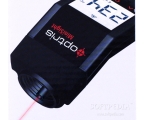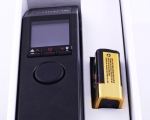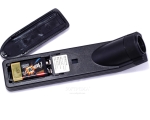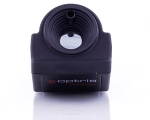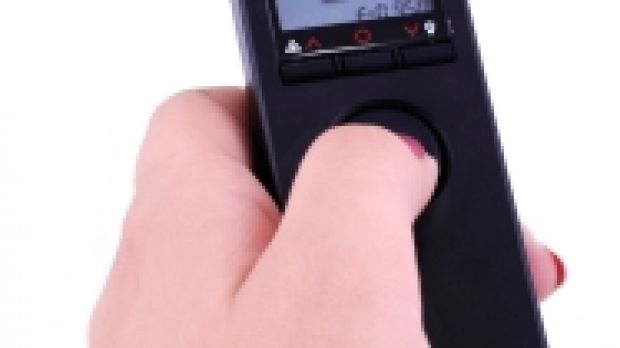Knowing the temperature of the surrounding environment has been quite an important problem for mankind, a problem that has finally been solved with the development of the thermometer. However, thermometers have evolved quite a lot over time, and just 4 years ago the next-generation of such devices emerged, with the development of IR thermometers.
And that's exactly the type of device that we're about to show you, namely the XTemp M from Optris, a precision instrument that really impressed all of the people around the office who've had the chance of using it, and especially yours truly.
First of all, I must tell you that quite honestly, when I've purchased it, I didn't really expect it to work this well. I was expecting a gadget (yes, an advanced one, but a gadget nonetheless), and what I got was a precision measurement instrument, fully capable of fulfilling industrial-grade tasks, as well as more ?mundane? ones, as for example measuring the temperature inside the fridge or at the tip of a cigarette. And that's not all, as you'll be able to find out later on in this review. But, in order to ?enlighten? a bit those of you who have no idea what an IR instrument is and how it works (I was part of this category just 2 weeks ago, before purchasing the aforementioned device), let's join the....
Science Class: IR Thermometers 101
Mr. John Merchant, Sales Manager of Mikron Instrument Company Inc. has written quite an interesting and comprehensive paper on the subject, called ?Infrared Temperature Measurement Theory and Application?, and I took the liberty of quoting him, since the explanations are offered in a very clear and simple language.
So, as Mr. Merchant informs us, ?IR energy is emitted by all materials above 0?K. Infrared radiation is part of the Electromagnetic Spectrum and occupies frequencies between visible light and radio waves. The IR part of the spectrum spans wavelengths from 0.7 micrometers to 1000 micrometers (microns). The IR energy travels in straight lines from the source and can be reflected and absorbed by material surfaces in its path. In the case of most solid objects which are opaque to the human eye, part of the IR energy striking the object's surface will be absorbed and part will be reflected. Of the energy absorbed by the object, a proportion will be re-emitted and part will be reflected internally. This will also apply to materials which are transparent to the eye, such as glass, gases and thin, clear plastics, but in addition, some of the IR energy will also pass through the object.
Different kinds of materials and gases have different emissivities, and will therefore emit IR at different intensities for a given temperature.?
Practically, the IR thermometer measures the emissivity of a certain surface, compares it to its own (which has a fixed value of 0.95) and, based on the value, supplies the value of the temperature at the surface of the body. It's as simple as that. The biggest shortcoming is that the device can't make accurate readings on reflective surfaces (polished metals, for examples, or mirrors), but there are several practical workarounds that can solve this problem as well (for example, using some adhesive tape on the mentioned surfaces might do the trick). Well, I won't be going into any details regarding the types of sensors contained within the device or the way they work, because - quite frankly - it would take too long and you'll probably get bored. I know I would. So, let's move along to....
Design and looks
If I were to describe this device in just one word, that word would probably be ?sleek?. The external device of the XTemp M is somewhat of a crossbreed between one of those ?phaser? things from Star Trek and....well, the nunchuck controller of Nintendo's Wii gaming console. The entire body is made of high quality black plastic - except for the sensor lens, main button, display and rubber grip - and looks very professional.
However, this is one case when looks are doubled by smarts, as the control system is extraordinary, as it is extremely easy to use, only one hand being required in order to operate the device. Actually, just the thumb, as the other fingers are used to get a hold of the rubber grip that doubles as a removable protection cap for the battery compartment. And there's not much for the thumb to do either, since the device has just 4 buttons, out of which only one is really important (the MODE button), and this one is the biggest. But enough about usage, since this chapter will be detailed as follows, in the.... User's Manual (ultra-short version)
OK, you really don't have to be a rocket scientist in order to use this device. Thus, all you have to do is press the big black round rubber button (it's only one, so you can't miss it) on the device, and then point the laser beam generated by the XTemp M towards the surface of the body whose temperature you're trying to measure. The IR sensors within the device will measure the emissivity of the respective body, and then turn the readings into Celsius degrees (or Fahrenheit, depending on the user's choice).
Moreover, you'll be able to see the maximum and minimum recorded temperatures for a certain body, by simply pushing the middle button (out of the three smaller buttons you can find right below the screen), and the device also has a ?HOLD? function, which keeps the last read temperature on the display for around 7 seconds. And if you happen to be measuring temperatures in the dark, no problem, as the display is backlight, the blue light being switched on by simply pressing the left smaller button.
The only problem you might come across while using this device is that of spot size and optical resolution. Thus - as the manufacturer informs us - the instrument's measuring beam has a diameter of 13 mm at any distance within 140 mm, and the spot size grows with distance (at 1 m the spot size is 5 cm). The ratio of the distance to the spot size (a.k.a. the optical resolution) is 20:1 at a distance of 1 m, so if you happen to go beyond that distance, you should just divide your distance to the object by 20. The main idea here is that the target area must be at least as large as the spot size, so you can't measure objects smaller than 13 mm.
That's quite enough help for the users of this device, now let's see what are the....
XTemp M list of specifications:
- dimensions: 190 x 38 x 45 mm; - weight: 150 grams; - battery: 9 V alkaline battery; - battery life: - 20 hours with laser on and backlight on 50%; - 40 hours with laser and backlight off; - temperature measurement range: -32 ? 429 Celsius degrees (-20 ? 788 Fahrenheit); - system reading accuracy: + 1%; - optical resolution: 20:1; - display resolution: 0.2 Celsius degrees (0.5 Fahrenheit); - response time: 300 ms; - ambient operating temperature: 0 ? 50 Celsius degrees; - emissivity value: fixed at 0.95; - features a display backlight; - laser beam: 9 mm offset, class IIa laser.
After carefully reading the list of specs and the user's manual, I decided to...well, you already know it....
Softpedia tested the XTemp M IR thermometer and saw that it was Hot
I couldn?t just write about a device without properly testing it first, could I? So I've decided to run some experiments with the help of the XTemp M. Some of those experiments are available in a previous review, the (Hot Beverages Via USB: The USB Coffee Warmer ), so we won't provide more information regarding them (apart from mentioning the fact that the measurements were done in that case with both a normal thermometer and this one), but that's not all that we've done with this very interesting device.
Test 1: Temperature inside a refrigerator:
We?ve measured the temperature inside the refrigerator from the company's kitchen/restroom. The built-in thermometer of the appliance read ? 18 degrees Celsius in the freezer and around 6 degrees Celsius in the rest and....to my actual surprise, it was perfectly accurate, according to the Xtemp M.
Test 2: Temperature at the tip of a cigarette:
Used as a test subject: one of my many smoker colleagues. The temperature at the tip of his cigarette was of around 250 degrees Celsius. Quite an interesting thing. Reminds me of why I quit smoking.
Test 3: Temperature on the neighboring roof:
No cat on that hot roof. And it was pretty hot (around 50 degrees Celsius, when the outside temperature was of around 28 degrees), since it was made out of steel sheets. Painted sheets, ?cause otherwise I couldn't have trusted the measurement.
Test 4: Temperature of a bottle of juice ?spitted? out by the vending machine:
Quite an impressive result here. 16 degrees Celsius. Juice tasted great.
Can't really say that I've carried out some really ?scientific? tests, but the results were pretty impressive. The Xtemp M does a very good job of measuring the temperature from a distance. And the same opinion is shared by all the people around the office, since they couldn't help testing it for themselves on all sorts of surfaces and devices. So, as you can see, it wasn't too difficult to make up my mind on....
The XTemp M IR Thermometer Roundup
What's Cool: Everything about this device is quite cool. Measuring the temperature of an object from a safe distance (and measuring it quite accurately) is quite impressive, especially when it is carried out by such a sleek and small device. The Xtemp M is very easy to use, it provides accurate readings and has a lot of possible practical uses, besides the scientific or industrial ones. Extra points for making such a useful device look so very cool.
What's not so Cool: Not much to say here. Maybe that the battery life isn't too great. And the fact that due to its functioning principle, the Xtemp M can't measure the temperature of polished or reflexive surfaces directly. And the thing about the spot distance. Other than that....nothing to complain about.
Conclusions
The XTemp M is really an interesting and very useful device. It?s quite proficient either for industrial purposes or for normal, domestic ones, and a great tool for testing temperature, regardless of the area of activity. The only problem is that its price, although not too high (the device is actually at entry level, from both price and features points of view), might scare off regular home users. The device is available in Romania at Micronix, for 99 Euro (sans VAT) and you can find it here.
Still Images from the Optris XTemp M IR Thermometer review
Photo: Tudor Raiciu

 14 DAY TRIAL //
14 DAY TRIAL // 